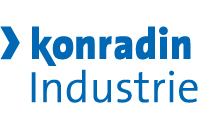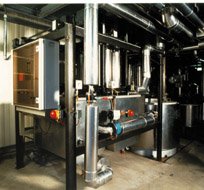Microfiltration plants should preferably work automatically under frequently changing conditions of process fluid streams or variable feeds. This flexibility can be achieved through regenerative microstructured layers. Separation-effective stabilizer materials are applied to the supporting membrane or added to the feed before each filtration cycle starts.
Dr. Uwe Hartmann
Anzeige
In einer Ära, in der die Chemieindustrie mit den Herausforderungen des Klimawandels und der Notwendigkeit einer nachhaltigen Entwicklung konfrontiert ist...
There is a wide range of applications for filtration plants with stainless-steel membranes, for example:
• separation of solids (microparticle separation),
• filtration of aggressive and abrasive suspensions,
• separation of powdered, activated carbon or other powdered adsorbents from suspensions,
• purification of waste water,
• filtration of oils and suspensions.
Numerous technical processes use catalysts in order to speed up or initiate chemical reactions. In simple cases the efficiency of catalytic systems can be increased by enlarging the reaction surface. The catalyst is therefore usually added in fine grades. This positive effect on the chemical reaction how-ever complicates the separation of the catalyst from the corresponding reaction mixture. Additional filtration steps are usually required. The high costs of precious-metal catalysts make recycling desirable. One practical solution might be the use of microfiltration plants equipped with tubular, stainless-steel membranes with regenerative layers e.g. made of cellulose fibers. Cellulose fibers have the advantage of burning up almost entirely. The precious and expensive catalyst can than be melted out of the structured layer.
Another field of application is the treatment of pickling wastes. Pickling solutions are used in grinding and polishing machines. Retaining fine particles, oils, grease and dirt by microfiltration using tubular, stainless-steel membranes with regenerative precoat layers is a highly suitable method of purifying and (if required) recycling the solutions. The concentrate dries to such an extent that most of it drops off the membranes in form of slabs and pieces. The remainder can be wiped off the membranes automatically with a scraper.
In the surface treatment industry, microfiltration plants with stainless-steel membranes can be used for continuous regeneration of process suspensions in a bypass mode. Nearly all degreasing baths use acid or alkaline detergents, containing surfactants and numerous additives. During the cleansing process these solutions become less and less efficient. Continuous regeneration by microfiltration with stainless-steel membranes in the bypass renews the cleansing agent by removing unwanted substances, thus enabling a considerable extension of the bath’s useful life.
Features of microfiltration plants
The stabilizer material applied to the stainless-steel membranes as microstuctured layers separates even the finest particles out of the liquid phase. Premature clogging of the membranes or break-throughs are thus effectively prevented. Many substances can be utilized as stabilizer material, for example cellulose fibers, silica gels, perlites, zeolites, activated carbons or other powdered adsorbents. The powdered stabilizer material is suspended in a storage tank with water (or, for example, with the permeate of oil if oil has to be filtered). The addition of powdered adsorbents to the microstructured layer enables dissolved, adsorbable substances to be separated easily and effectively.
This type of filtration process avoids clogged or damaged membranes. It saves energy too, since no surface layer compression occurs, as is the case with pressure filtration, and there is no cross-flow of large feed volumes. As soon as the permeate flow falls below a presettable threshold, the membranes are lifted from the feed recipient, and the retained residue – including the microstructured layer – is dried while still under vacuum. An automatically operated stripper removes the residue, which is dried to a large extent, together with the original filter-effective layer. Most of the dried residue drops off of the stainless-steel membranes in the form of slabs or pieces, together with the original stabilizer material.
Irreversible clogging of the stainless-steel membranes is impossible, since every filtration cycle begins with the application of a new filter-effective layer, exhibiting membrane characteristics. Conventional filter modules, with their housings, pressure pumps and membranes, are no longer employed in this microfiltration plant. Instead, the unit is characterized by energy savings and functionally efficient separation into mobile and stationary components.
Altenburger
Fax: 0049/7823/50997
cpp-237
Unsere Webinar-Empfehlung
Die Websession „Wasserstoff in der Chemie – Anlagen, Komponenten, Dienstleistungen“ (hier als Webcast abrufbar) zeigt technische Lösungen auf, die die Herstellung und Handhabung von Wasserstoff in der chemischen Industrie sicher machen und wirtschaftlich gestalten.
Ob effizienter…
Teilen:














